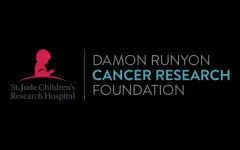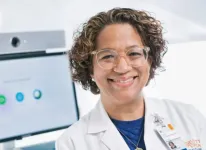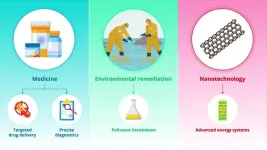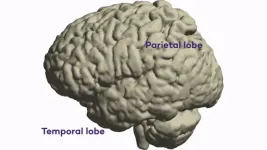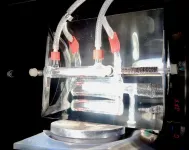(Press-News.org) New York, New York, and Memphis, Tennessee, February 13, 2025
The Damon Runyon Cancer Research Foundation and St. Jude Children’s Research Hospital have announced their newest class of pediatric cancer research fellows, each of whom will receive funding for four years ($300,000 total) to support an innovative research project with the potential to significantly impact the diagnosis or treatment of one or more pediatric cancers.
Launched in 2024, the Damon Runyon-St. Jude Pediatric Cancer Research Fellowship aims to address a funding gap that drives top talent to seek more prevalent opportunities in adult cancer research or the pharmaceutical sector. Fellows are selected by a distinguished committee of leaders in the field.
"This partnership between Damon Runyon and St. Jude was created to give the top researchers across the U.S. the support they need to pursue the most promising breakthroughs for children with cancer," said James R. Downing, MD, St. Jude president and CEO. “Whether it's at St. Jude or elsewhere, each advancement in our understanding of childhood cancer moves us closer to realizing our mission of finding cures and saving children everywhere."
In addition to all the benefits associated with a fellowship from Damon Runyon, including the retirement of up to $100,000 of medical school debt, Pediatric Fellows are invited to attend an annual meeting with their colleagues hosted by the St. Jude Comprehensive Cancer Center.
“The selection committee was very enthusiastic about these scientists, who each meet the goals of this important new program,” said Yung S. Lie, PhD, President and CEO of Damon Runyon. “We are incredibly grateful to St. Jude for their partnership and confident that this brilliant cohort will make a meaningful impact in pediatric cancer research.”
2025 Damon Runyon-St. Jude Pediatric Cancer Research Fellows
Ian Blumenthal, PhD, with his sponsor Jim M. Olson, MD, PhD, at Seattle Children's Research Institute, Seattle
Diffuse midline gliomas (DMG) are uniformly fatal pediatric brain cancers in desperate need of novel treatments. Immunotherapies have offered some hope to patients, but durable clinical success remains elusive, highlighting the enormous challenge of selectively targeting these recalcitrant tumors while preserving healthy tissue. Dr. Blumenthal aims to address this need by building immune cell engagers—molecules that enable a patient’s immune cells to recognize and attack their tumor—that are capable of leveraging DMG’s inherent variability and immune defense mechanisms into a therapeutic advantage. He hopes that these innovative drug designs will not only provide superior efficacy against pediatric gliomas but also pave the way for next-generation immunotherapies that better address the dynamic nature of tumor biology. Dr. Blumenthal received his PhD from the University of Washington, Seattle and his BA and BE from Dartmouth College, Hanover.
Matthew Decker, MD, PhD, with his sponsor Kevin M. Shannon, MD, at University of California, San Francisco
Acute myeloid leukemia (AML) is hard to cure compared to other childhood leukemias and lymphomas. Current standard-of-care AML treatment is very toxic; childhood AML survivors often have side effects later in life from their treatment, including heart disease, infertility, and additional cancers. There is a pressing need for new AML treatments that are less toxic and more effective. Dr. Decker’s research is focused on developing novel inhibitors of a protein called N-Ras, one of the most common mutations in pediatric AML. Dr. Decker hopes by disrupting N-Ras function to sensitize AML to existing therapies and improve outcomes for patients. Dr. Decker received his MD and PhD from Columbia University, New York and his BS from Stanford University, Stanford.
Oriana Miltiadous, MD, with her sponsors Andrew L. Kung, MD, PhD (Memorial Sloan Kettering Cancer Center), and Marcel van den Brink, MD, PhD (City of Hope), at Memorial Sloan Kettering Cancer Center, New York
Dr. Miltiadous is investigating how the gut microbiome affects the immune system in children undergoing a cancer treatment called allogeneic hematopoietic cell transplantation (allo-HCT), which is often used for aggressive pediatric cancers like leukemia and lymphoma. While it can be life-saving, allo-HCT can also induce complications caused by immune overactivation, including graft-versus-host disease. Molecules called bile acids, produced with the help of gut microbes, help balance the immune response, reducing harmful inflammation and improving recovery. By identifying specific gut microbes and bile acids that support immune function, Dr. Miltiadous aims to reduce complications, improve survival rates, and enhance the quality of life for children receiving allo-HCT. By analyzing a cohort of over 400 patients, she seeks to uncover actionable insights that could lead to new therapies targeting the gut microbiome. Dr. Miltiadous received her MD from the University of Athens Medical School, Athens.
Geoffrey Smith, MD, PhD, with his sponsor Tyler Jacks, PhD, at Dana-Farber Cancer Institute, Boston
In the past decade, new therapies that train the immune system to recognize and kill tumor cells have revolutionized cancer care. Unfortunately, immunotherapies have been largely ineffective in pediatric solid tumors, including osteosarcoma, the most common bone cancer. Dr. Smith aims to understand why immunotherapies have failed by studying a mouse model closely resembling human osteosarcoma. Importantly, these mice have an intact immune system, unlike models that transplant human tumors into mice. By combining complex modeling with single cell and spatial techniques, Dr. Smith hopes to uncover barriers to immune control of osteosarcoma and identify potential therapeutic approaches. Based on these findings, he plans to test novel immunotherapies in the mouse model to prepare for the next generation of osteosarcoma human clinical trials. Dr. Smith received his MD and PhD from the University of California, San Francisco and his BA from Harvard College, Cambridge.
Lara Wahlster, MD, PhD, with her sponsor Vijay G. Sankaran, MD, PhD, at Dana-Farber Cancer Institute, Boston
Dr. Wahlster is studying the developmental origins of acute lymphoblastic leukemia (ALL), the most common childhood cancer and leading cause of death in children. The goal of Dr. Wahlster’s research is to understand the biological processes that drive blood cancer development. Applying innovative genomic tools, her work seeks to decipher how cancer-predisposing genetic variants impact early blood cell development and facilitate the acquisition of secondary genetic changes found in ALL. She aims to leverage these insights to guide the development of novel, mechanism-based treatments. Dr. Wahlster earned her MD and PhD from the University of Heidelberg, Heidelberg.
Tuyu Zheng, PhD, with her sponsor Stephen C. Mack, PhD, at St. Jude Children's Research Hospital, Memphis
Ependymomas (EPN) are aggressive brain and spinal cord tumors that are especially difficult to treat in children and often come back after treatment. Recent research has shown that interactions between tumor cells and healthy neurons play a key role in EPN growth. It is not well understood, however, how exactly neurons contribute to this process. By mapping the neuronal environment and exploring the different types of neurons involved, Dr. Zheng hopes to uncover the mechanisms that drive EPN growth and find new ways to treat these tumors. Dr. Zheng received her PhD from Heidelberg University, Heidelberg, her MEng and MSc from the University of Technology of Compiègne, Compiègne, and her BEng from Shanghai University, Shanghai.
***
Damon Runyon Cancer Research Foundation
To accelerate breakthroughs, the Damon Runyon Cancer Research Foundation provides today's best young scientists with funding to pursue innovative research. The Foundation has gained worldwide prominence in cancer research by identifying outstanding researchers and physician-scientists. Thirteen scientists supported by the Foundation have received the Nobel Prize, and others are heads of cancer centers and leaders of renowned research programs. Each of its award programs is extremely competitive, with less than 10% of applications funded. Since its founding in 1946, in partnership with donors across the nation, the Damon Runyon Cancer Research Foundation has invested over $470 million and funded more than 4,000 scientists.
St. Jude Children's Research Hospital
St. Jude Children's Research Hospital is leading the way the world understands, treats and cures childhood cancer, sickle cell disease, and other life-threatening disorders. It is the only National Cancer Institute-designated Comprehensive Cancer Center devoted solely to children. Treatments developed at St. Jude have helped push the overall childhood cancer survival rate from 20% to 80% since the hospital opened more than 60 years ago. St. Jude shares the breakthroughs it makes to help doctors and researchers at local hospitals and cancer centers around the world improve the quality of treatment and care for even more children. To learn more, visit stjude.org, read St. Jude Progress, a digital magazine, and follow St. Jude on social media at @stjuderesearch.
END
Damon Runyon Cancer Research Foundation and St. Jude Children’s Research Hospital invest $1.8 million in childhood cancer research
Cancer researchers in Seattle, San Francisco, Boston, New York and Memphis were selected as Pediatric Fellows
2025-02-13
ELSE PRESS RELEASES FROM THIS DATE:
New ACS study finds menthol flavored cigarette smoking increases mortality risk vs. non-menthol cigarettes
2025-02-13
In a large, nationwide study led by the American Cancer Society (ACS), researchers found mortality risks for smoking menthol cigarettes were higher than non-menthol cigarettes for death from any cause and cardiovascular diseases, especially heart diseases. Higher risks were evident in individuals who had quit smoking and at high smoking intensities. Black participants currently smoking menthol brands had high increases for some heart diseases with an 88% elevated mortality risk compared to non-menthol cigarettes. ...
Discussing barriers, concerns key for getting older adults vaccinated
2025-02-13
A clear endorsement from their healthcare provider and being supplied information about recommended vaccines before their clinic visit spurred more older Americans to get vaccinated, a new University of Virginia School of Medicine study found.
Because immune systems age like the rest of the body, older adults are at higher risk for poor outcomes from infections. But only 15% of Americans ages 50 and older and 25% of Americans ages 65 and older are up to date on all recommended vaccines, including flu, RSV, tetanus and pneumococcal disease.
In the study, six primary care clinics across America piloted a new approach to boosting vaccination rates. This included ...
Regular access to therapy dogs boosts first-year students’ mental health
2025-02-13
PULLMAN, Wash. — College students who spent a little bit of free time each week interacting with therapy dogs on campus during their first semester experienced fewer signs of stress and depression than those who did not.
That’s according to the PAWs4US study, a new paper published in Pets that examined how regular, long-term access to an animal-assisted drop-in program at Washington State University influenced first-year students’ mental health.
The study found that students who engaged with therapy dogs in repeated, unstructured sessions over several months not only ...
The complicated question of how we determine who has an accent
2025-02-13
COLUMBUS, Ohio – How do you tell if someone has a particular accent? It might seem obvious: You hear someone pronounce words in a way that is different from “normal” and connect it to other people from a specific place.
But a new study suggests that might not be the case.
“People probably don’t learn who has an accent from hearing someone talk and thinking, ‘huh, they sound funny’ – even though sometimes it feels like that’s how we do it,” said Kathryn Campbell-Kibler, author of the study and associate professor of linguistics at The Ohio State University.
Accents may be ...
NITech researchers shed light on the mechanisms of bacterial flagellar motors
2025-02-13
When speaking of motors, most people think of those powering vehicles and human machinery. However, biological motors have existed for millions of years in microorganisms. Among these, many bacterial species have tail-like structures—called flagella—that spin around to propel themselves in fluids. These movements employ protein complexes known as the “flagellar motor.”
This flagellar motor consists of two main components: the rotor and the stators. The rotor is a large rotating structure, anchored to the cell membrane, that turns the flagellum. On the other hand, the stators are smaller ...
Study maps new brain regions behind intended speech
2025-02-13
Broca’s aphasia is caused by damage to the frontal lobe, leaves patients unable to say what they intend to say
First study to identify regions outside the frontal lobe that encode the intent to speak
Critical for technology to avoid decoding a patient’s thoughts that are not intended to be spoken aloud
CHICAGO --- Imagine seeing a furry, four-legged animal that meows. Mentally, you know what it is, but the word “cat” is stuck on the tip of your tongue.
This phenomenon, known as Broca’s aphasia or expressive aphasia, is a language disorder that affects a person’s ability to speak or ...
Next-gen Alzheimer’s drugs extend independent living by months
2025-02-13
In the past two years, the Food and Drug Administration has approved two novel Alzheimer’s therapies, based on data from clinical trials showing that both drugs slowed the progression of the disease. But while the approvals of lecanemab and donanemab, both antibody therapies that clear plaque-causing amyloid proteins from the brain, were greeted with enthusiasm by some Alzheimer’s researchers, the response of patients has been muted. According to physicians who care for people with Alzheimer’s, many patients found it difficult to understand what the clinical trials results — presented as “percent decrease in ...
Jumping workouts could help astronauts on the moon and Mars, study in mice suggests
2025-02-13
Jumping workouts could help astronauts prevent the type of cartilage damage they are likely to endure during lengthy missions to Mars and the Moon, a new Johns Hopkins University study suggests.
The research adds to ongoing efforts by space agencies to protect astronauts against deconditioning/getting out of shape due to low gravity, a crucial aspect of their ability to perform spacewalks, handle equipment and repairs, and carry out other physically demanding tasks.
The study, which shows knee cartilage in mice grew healthier following jumping exercises, appears ...
Guardian molecule keeps cells on track – new perspectives for the treatment of liver cancer
2025-02-13
A guardian molecule ensures that liver cells do not lose their identity. This has been discovered by researchers from the German Cancer Research Center (DKFZ), the Hector Institute für Translational Brain Research (HITBR), and from the European Molecular Biology Laboratory (EMBL). The discovery is of great interest for cancer medicine because a change of identity of cells has come into focus as a fundamental principle of carcinogenesis for several years. The Heidelberg researchers were able to show ...
Solar-powered device captures carbon dioxide from air to make sustainable fuel
2025-02-13
Researchers have developed a reactor that pulls carbon dioxide directly from the air and converts it into sustainable fuel, using sunlight as the power source.
The researchers, from the University of Cambridge, say their solar-powered reactor could be used to make fuel to power cars and planes, or the many chemicals and pharmaceuticals products we rely on. It could also be used to generate fuel in remote or off-grid locations.
Unlike most carbon capture technologies, the reactor developed by the Cambridge researchers does not require fossil-fuel-based power, or the transport and storage of carbon dioxide, but instead converts atmospheric CO2 into something useful using sunlight. ...
LAST 30 PRESS RELEASES:
Norbert Holtkamp appointed director of Fermi National Accelerator Laboratory
New agentic AI platform accelerates advanced optics design
Biologists discover neurons use physical signals — not electricity — to stabilize communication
Researchers discover that a hormone can access the brain by hitchhiking
University of Oklahoma researcher awarded funding to pursue AI-powered material design
Exploring how the visual system recovers following injury
Support for parents with infants at pediatric check-ups leads to better reading and math skills in elementary school
Kids’ behavioral health is a growing share of family health costs
Day & night: Cancer disrupts the brain’s natural rhythm
COVID-19 vaccination significantly reduces risk to pregnant women and baby
The role of vaccination in maternal and perinatal outcomes associated with COVID-19 in pregnancy
Mayo Clinic smartwatch system helps parents shorten and defuse children's severe tantrums early
Behavioral health spending spikes to 40% of all children’s health expenditures, nearly doubling in a decade
Digital cognitive behavioral treatment for generalized anxiety disorder
Expenditures for pediatric behavioral health care over time and estimated family financial burden
Air conditioning in nursing homes and mortality during extreme heat
The Alps to lose a record number of glaciers in the next decade
What makes a good proton conductor?
New science reporting guide published for journalists in Bulgaria
New international study reveals major survival gaps among children with cancer
New science reporting guide published for journalists in Turkey
Scientists develop a smarter mRNA therapy that knows which cells to target
Neuroanatomy-informed brain–machine hybrid intelligence for robust acoustic target detection
Eight SwRI hydrogen projects funded by ENERGYWERX
The Lundquist Institute and its start-up company Vitalex Biosciences Announces Strategic Advancement of Second-Generation fungal Vaccine VXV-01 through Phase 1 Trials under $40 Million Competitive Con
Fine particles in pollution are associated with early signs of autoimmune disease
Review article | Towards a Global Ground-Based Earth Observatory (GGBEO): Leveraging existing systems and networks
Penn and UMich create world’s smallest programmable, autonomous robots
Cleveland researchers launch first major study to address ‘hidden performance killer’ in athletes
To connect across politics, try saying what you oppose
[Press-News.org] Damon Runyon Cancer Research Foundation and St. Jude Children’s Research Hospital invest $1.8 million in childhood cancer researchCancer researchers in Seattle, San Francisco, Boston, New York and Memphis were selected as Pediatric Fellows
